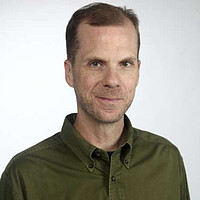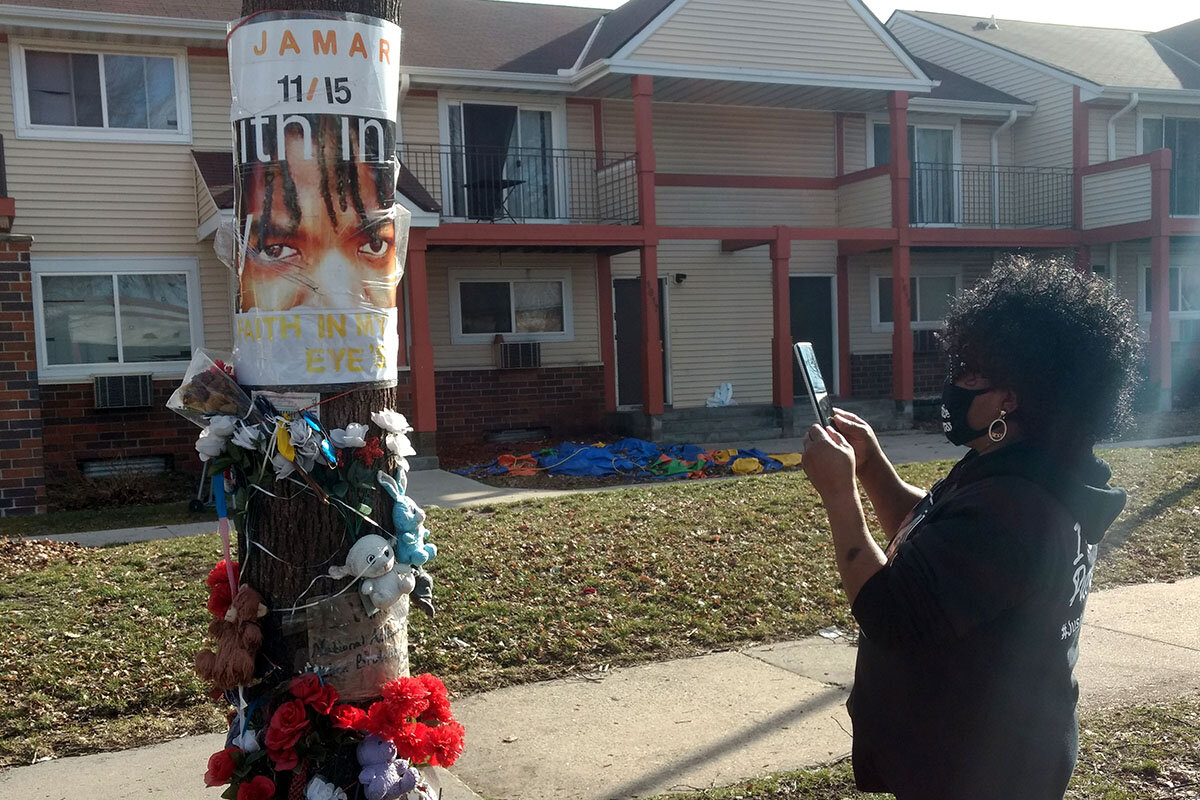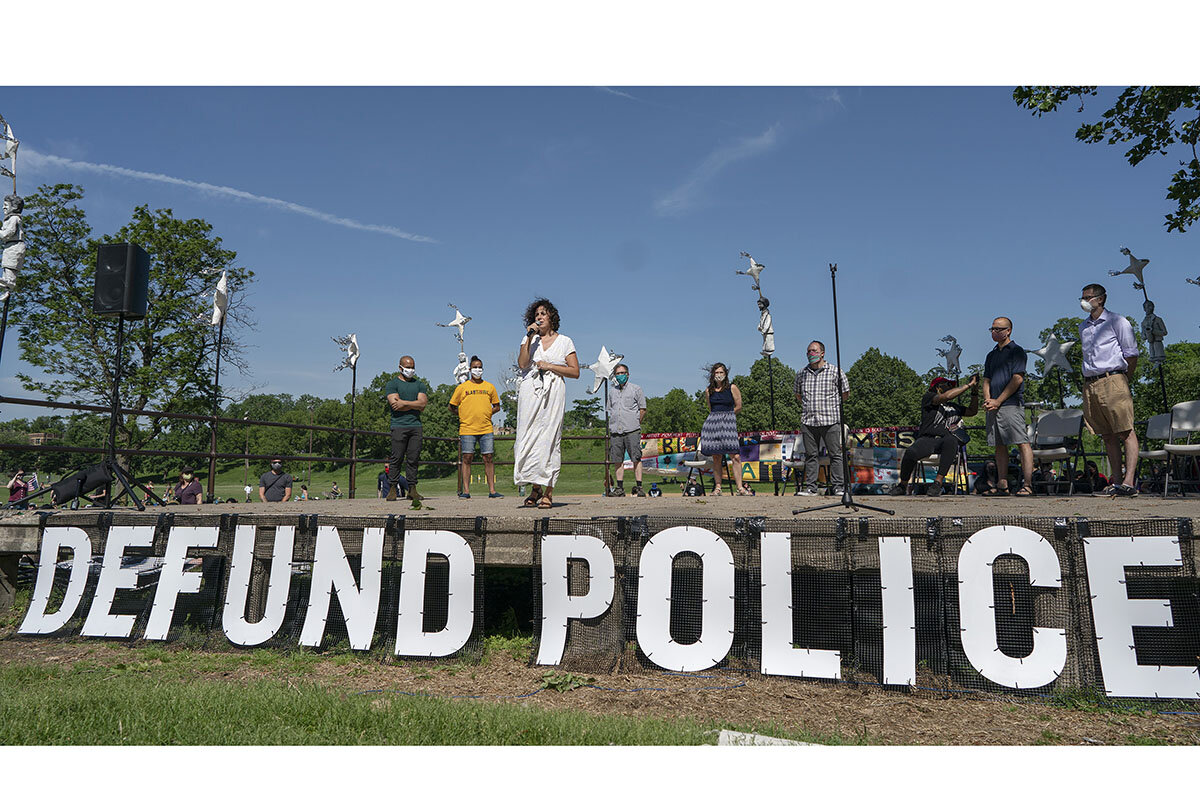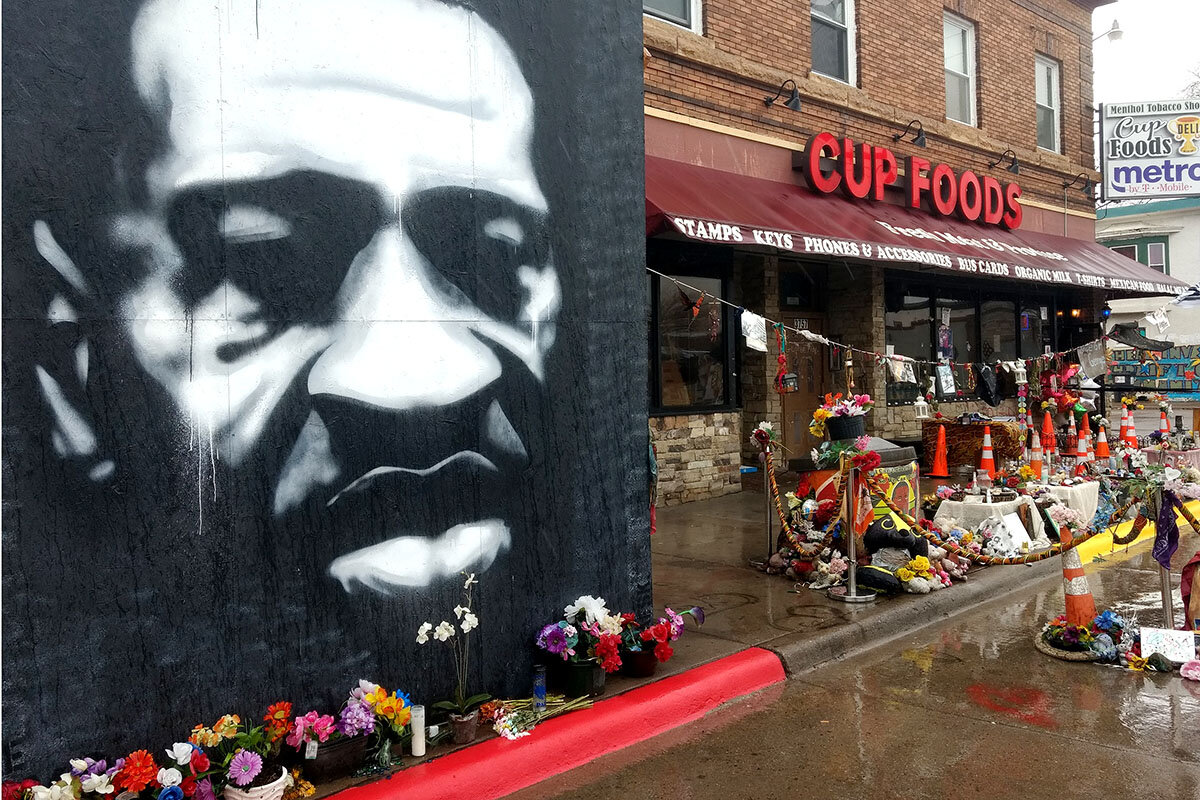Chauvin trial: Why Minneapolis activists are looking beyond the verdict
Loading...
| Minneapolis
The eyes of Jamar Clark peer out from a poster attached to a tree near the spot where a Minneapolis police officer shot and killed him in 2015. On a recent afternoon, Irma Burns stood beside the makeshift memorial with phone in hand, taking photos of the image of her dead son.
Mr. Clark’s fatal shooting six years ago ignited an 18-day protest outside the 4th Precinct police station two blocks away. The upheaval laid bare long-running tensions between the city’s communities of color and its mostly white police force – tensions that continued to build before detonating last May when officers killed George Floyd.
“Our Black community has been hurting a long time,” Ms. Burns says. Local and federal authorities declined to bring charges against the two white officers involved in the death of the 24-year-old Mr. Clark, the youngest of her 10 children. “What happened to George was just the latest tragedy.”
Why We Wrote This
George Floyd’s death changed the conversation on police in America, launching the biggest civil rights movement in 50 years. What will Derek Chauvin’s trial mean for that movement?
The video of Officer Derek Chauvin kneeling on Mr. Floyd’s neck as two other officers held him down and a third stood by touched off nationwide protests against police brutality and racial inequality. The uproar gave rise to the country’s broadest grassroots movement since the civil rights era as supporters called for Minneapolis and other cities to defund and reform police departments and rethink violence prevention strategies.
Ten months later, with Mr. Chauvin’s murder trial underway at a downtown courthouse fortified by concrete barricades, armored military vehicles, and National Guard troops, momentum for change has slowed and splintered here. An increase in violent crime in Minneapolis since Mr. Floyd’s death has fanned opposition to new public safety models, while the pandemic has compounded racial disparities in income, housing, and health care.
The trial of Mr. Chauvin – who faces charges of second- and third-degree murder and manslaughter – has deepened the sense of foreboding in the state’s largest city. The prospect of the 12-member jury acquitting the former officer stirs concerns among residents that Minneapolis could erupt in fury again, imperiling progress on public safety reforms.
Ms. Burns and her fellow advocates, convinced that the trial’s emotional toll will fall hardest on minority residents, intend to sustain pressure on local officials to remedy the city’s policing problems, irrespective of the verdict. They view the outcome and the potential for unrest in the context of the ceaseless fight for racial justice.
“I pray the jury does the right thing, but what people want is bigger than one trial,” Ms. Burns says. She took part in a rally outside the 4th Precinct last week to boost a ballot initiative that would establish a new civilian commission on police accountability. “We want systemic change.”
As competing proposals to shape the future of the police department vie for public attention, activists and organizers recognize that the trial’s verdict could have profound effect on their ability to recruit and retain supporters. Trahern Crews, the lead organizer of Black Lives Matter Minnesota, suggests that a conviction would prove at once cathartic and galvanizing for people of color in Minneapolis and beyond.
“I feel like the whole city is on edge, because the world is watching us,” he says. “It’s one of the most important trials in the history of the country, and we need a win. The Black community needs a win. A guilty verdict will reenergize us.”
“Live in the nuance”
Nine members of the Minneapolis City Council appeared on a stage in a city park less than two weeks after Mr. Floyd’s death last spring. The words “Defund Police” adorned the front of the platform, and the officials vowed to “end policing as we know it,” drawing cheers from the hundreds of people gathered.
The pledge earned national headlines and praise from progressive activists, who had pressed council members to take decisive action as the city reeled and raged. Days later, the 13-member council unanimously passed a resolution to initiate a yearlong process to “create a transformative new model for cultivating safety” – a signal that pursuing reforms would require patience as much as persistence.
The resolution received far less notice, and then as now, Council Member Phillipe Cunningham, who addressed the crowd in the park in June, emphasized the difference between proclaiming change and forging policy.
“I believe we need to reimagine public safety, but defunding the police is a transition – it’s not an end goal or a strategy,” he says. “Just taking money away from police isn’t enough because public safety involves much more than policing.”
His perspective tracks with popular opinion in Minneapolis. A poll conducted in August found that almost three-fourths of residents favored redirecting a portion of police funding to mental health, drug treatment, and other social services. At the same time, 60% of respondents overall – and 75% of Black respondents – opposed or expressed uncertainty about reducing the size of the force.
National polls show a similar preference for revamping rather than gutting police departments, and Minneapolis officials began to recalibrate public safety resources in December. The council passed a measure that maintained the maximum number of officers at 888 while slicing $8 million from the department’s budget to expand the Office of Violence Prevention and fund crisis response teams.
“To say that we have to either add more police and jails or we have to solve racism – that those are the only two options – doesn’t reflect the realities of creating policy,” says Mr. Cunningham, who co-wrote the initiative. “You have to live in the nuance.”
Progressive activists counter that officials have failed to fulfill the expectations they raised with their declaration in the park, and with reform caught in the gears of bureaucracy, the city has endured a spike in homicides, robberies, and other violent crimes.
“There was a worldwide outcry to dismantle the police,” says Nekima Levy Armstrong, a civil rights attorney who leads the Racial Justice Network. “Ten months later, it’s clear our elected officials did not take that seriously.”
The pace of reform
Ms. Levy Armstrong, former president of the local NAACP chapter, recalls protesting Mr. Clark’s death at the hands of police in 2015. She says city leaders largely ignored the pleas of communities of color to embrace new public safety strategies and divert more money to social programs.
The gulf separating the respective budgets of the police department and the Office of Violence Prevention – $170 million vs. $7.4 million – gives her little reason to hope that the near future will depart from the recent past.
“If the current system worked,” she says, “Derek Chauvin would not have felt comfortable putting his knee on George Floyd’s neck at all, let alone for nine minutes.”
The council approved an agreement with the state last summer that bans Minneapolis officers from applying chokeholds and strengthens rules that they must intervene when colleagues use excessive force. Yet activists complain that police remain too quick to escalate confrontations. A video emerged last week that showed an officer punching a Black teenager in the head in the confused aftermath of an apparent carjacking.
“Police keep harming people,” says JaNaé Bates, communications director with ISAIAH, a statewide network of faith organizations that promotes racial justice. “That’s the elephant in the room – we can’t get the safety results we want with the group of people we hire to do the job.”
Minneapolis officials agreed earlier this month to pay $27 million to Mr. Floyd’s family to settle a civil lawsuit over his death. For D.A. Bullock, a Minneapolis organizer and filmmaker, the true worth of the payment – one of the largest of its kind in the country’s history – will be revealed by the city’s commitment to preventing police-involved deaths.
“The $27 million is not enough value for a life,” he says. “So the value will be making sure that what happened to George Floyd never happens again.”
At George Floyd Square
The intersection where police killed Mr. Floyd soon evolved into a memorial site that provided the backdrop to a city’s sorrow. Visitors wrote chalk messages of grief, anger, and resolve on the pavement and laid flowers beneath a mural of Mr. Floyd. They came to mourn, to commune with one another, to find solace among neighbors and strangers alike.
The displays of comity have since given way to a physical and emotional hollowness. In the four-block area now known as George Floyd Square, barricades impede vehicles from entering and activists occupy checkpoints to keep out police.
Officers bypass the so-called autonomous zone to avoid provoking confrontations. Their absence has coincided with a surge in gun violence in and around the square, including a fatal shooting earlier this month. The bloodshed has devastated the area’s shops and restaurants.
Dwight Alexander, who co-owns Smoke in the Pit, estimates business at his BBQ joint has plunged 75% in recent months. He has heard from longtime customers who fear walking into the square and from delivery drivers turned away at the barriers. He and other business owners accuse city officials and police of abandoning the neighborhood.
“I’ve been running this place for nine years. Cops used to come by to see how we were doing, but not a single person from the city has checked on me since all this started,” Mr. Alexander says. He thumped a fist against his chest. “They left me!”
Next door at Just Turkey, owner Sam Willis, who opened his restaurant in October, echoes the lament. He has talked with Mayor Jacob Frey and Police Chief Medaria Arradondo about the plight of businesses and residents – a screenshot on his phone shows him on a Zoom call with them – and has waited for the city to act. Both officials have announced that the autonomous zone will remain largely closed off until after Mr. Chauvin’s trial.
“Everybody here wants justice for George Floyd and wants this to be a place that always honors his memory,” says Mr. Willis, the father of four children. “But we also have families to support, and it’s a struggle right now.”
Turning aspirations into policy
The increase in violent crime in the neighborhoods around the square mirrors a citywide trend and overlaps with a steep loss in police personnel. Following last year’s upheaval over Mr. Floyd’s death – rioters torched the 3rd Precinct building and destroyed or damaged 1,500 businesses – the department endured a wave of retirements and resignations, and dozens of other officers have taken extended leaves.
The exodus has reduced the force by some 200 officers and prompted a lawsuit from a group of residents who seek to force the city to beef up the department to fight the rise in violence. Last month, the City Council approved a $6.4 million funding request from police officials to add dozens more officers, a decision that reform advocates cast as short-sighted.
“You shouldn’t have to choose between no police and violent police,” Ms. Levy Armstrong says. “There needs to be other ways to ensure community safety.”
Voters could have an opportunity to weigh alternatives this fall. A coalition of progressive groups has launched a petition drive for a ballot initiative that would replace the police force with a new Department of Public Safety by amending the city charter.
A similar amendment that could appear on the November ballot, proposed by Mr. Cunningham and two other council members, would include a law enforcement division within the new public safety agency. Both proposals treat violence prevention as a matter of public health and put forth a concept of community safety that relies less on force and more on trust.
“We can’t let everything we do be steeped in fear,” Mr. Bullock says. “That’s what has gotten us to this point with policing in America. We don’t have to dial 911 because somebody’s music is too loud.”
A convenience store clerk called police after Mr. Floyd tried to buy cigarettes with a fake $20 bill, setting in motion the arrest that led to his death. Mr. Cunningham, who has assured activists that the council will drop its proposal if the petition drive succeeds, wants residents to reimagine public safety as a kind of community contract that they keep with each other, rather than placing the entire onus on cops.
“People have been socially conditioned to believe that the police are the answer to almost every safety question that comes up in their lives,” he says. “That’s what we’re pushing back against.”
Racial justice advocates regard Mr. Chauvin’s trial as a chance to turn their aspirations into policy. Mike Griffin’s immersion in police reform began with the death of Jamar Clark six years ago. An electoral organizer with Community Change Action, a national advocacy group, he senses the momentum shifting at last.
“Progress happens slowly – that’s the history of this country,” he says. “But there’s not been a moment like this. George Floyd’s death fundamentally changed the conversation on police in this country. This is a 21st-century civil rights movement.”










